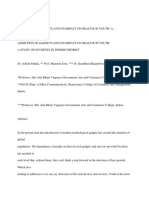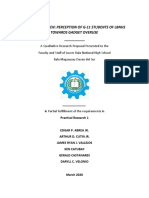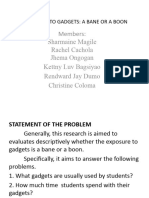0% found this document useful (0 votes)
11 views7 pagesSP Jan - Feb - 66
This study examines the detrimental effects of electronic gadget overuse on the mental health, emotional abilities, and social behavior of adolescents. With approximately 40% of adolescents currently using electronic gadgets excessively, the research highlights issues such as anxiety, depression, and social isolation stemming from this addiction. The paper aims to explore the extent of addiction, its impact on various abilities, and the socio-demographic factors influencing these effects.
Uploaded by
sirano1025Copyright
© © All Rights Reserved
We take content rights seriously. If you suspect this is your content, claim it here.
Available Formats
Download as PDF, TXT or read online on Scribd
0% found this document useful (0 votes)
11 views7 pagesSP Jan - Feb - 66
This study examines the detrimental effects of electronic gadget overuse on the mental health, emotional abilities, and social behavior of adolescents. With approximately 40% of adolescents currently using electronic gadgets excessively, the research highlights issues such as anxiety, depression, and social isolation stemming from this addiction. The paper aims to explore the extent of addiction, its impact on various abilities, and the socio-demographic factors influencing these effects.
Uploaded by
sirano1025Copyright
© © All Rights Reserved
We take content rights seriously. If you suspect this is your content, claim it here.
Available Formats
Download as PDF, TXT or read online on Scribd
/ 7
























































































